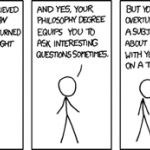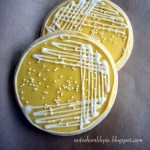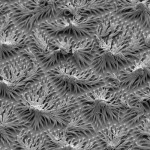Science
I went to see Randall Munroe, creator of xkcd, a few weeks ago at MIT. Unfortunately the line to get him to sign books was about fifty frenzied geeks long, so I didn't stay for that. But I did enjoy his dialogue with the audience, which mainly consisted of answering questions ranging from obsessive fanboy minutia (why is xkcd published on Monday, Wednesday and Friday?) to vast and metaphysical (what is the true difference between geeks, nerds and dorks?) The latter question led to Munroe doodling and tinkering with a ridiculously convoluted Venn diagram, the details of which I can't remember…
There isn't all that much news for a real obsessive update, so I'll lump in a few writing-related items of possible interest to people who read books other than mine.
A real obsessive update item: BradDeLong doubts my book can help his dog.
How to Teach Physics to Your Dog gets four out of five stars as part of a good books round-up in the Timmins Daily Press in Ontario. (Google News search is nifty).
A fortuitous discovery thanks to, of all things, an ad in GMail: QM for cat lovers, part of an old blog of imaginary conversations with Einstein. I doubt this will change anybody's mind about…
A couple of days ago, the LHC Blog asked about the future funding of the arxiv pre-print server, currently hosted at Cornell. Cornell is looking to get some external funding, though:
Currently the plan is to ask the "heaviest user institutions" (other university library systems) to voluntarily contribute to support arXiv operational costs. The FAQ states that the library has already secured commitments from 11 of the 20 institutions that make the most use of the arXiv. (I've seen an unofficial list; these include many of the 'big name research institutes' around the world.) In return, besides…
This explanatory video from Wired/the Exploratorium shows how "Dr. Megavolt" (Austin Richards) created a birdcage-topped stainless steel bodysuit, so he can play with the giant Tesla coil he built. This guy knows how to have fun, man.
Who: Richard Wiseman
What: free public presentation, "Investigating the Impossible"
Where: University Settlement, 184 Eldridge Street (and Rivington St.) [map]
When: 730pm, Tuesday, 5 January 2010
Cost: FREE and open to the public!
Join the New York City Skeptics as they kick off their 2010 Public Lecture Series with noted skeptic, psychologist, and magician Richard Wiseman.
For over 20 years, Professor Richard Wiseman has investigated a variety of strange psychological phenomena. In this talk, he describes some of his more colorful adventures, including his work into why some people are…
Many of the commenters on my earlier post about the so-called wisdom of crowds, "Science is not a democracy," have expressed distaste for the phrase "scientific consensus." I don't really share that distaste, and here's why.
To me, it's like being disturbed by the phrase "electoral college." You may detest the way our nation's electoral system works; you may not trust the outcomes it produces; but there is an established system, and the electoral college is part of it. You can object to the existence of the electoral college and criticize its characteristics, and you can try to change the…
Today is Question Day when it comes to post topics, I guess. Over at Fine Structure, Nick asks about the effect of spotlighting brilliant scientists:
I can't help but think about the repercussions of looking at his clearly above average career as something that's normal in physics. It's a deterrent, I think, for all those students that aren't so completely brilliant that they do Nobel winning physics by 21. And it's not exactly uncommon to hear about these minds anymore. Is it a function of community density when we funnel all the supremely smart people towards math and science? What does it…
Over at Faraday's Cage, Cherish is thinking about gender color codes:
I know I may be in the minority here, but let's look at it this way: if someone might consider getting a microscope or telescope for a girl because it's pink rather than a traditional "girl toy" (read: BARBIE) in the absence of a pink microscope or telescope, hasn't something good been done?
How much of the "pinkification" is as a result of adult notions of what a girl versus boy can do? And if a microscope is colored pink (or a baseball mitt or whatever else) means that the adults around that girl will be willing to…
Here's another of Casey Dunn's Creature Casts, this time on shifting color spots in marine snails.
CreatureCast - Flamingo Tongue Snails from Casey Dunn on Vimeo.
Pigment cells are always very, very cool. I've been intrigued by them for a long time — they show up in my time-lapse recordings of developing zebrafish and are always active. Here's a quick one, a few hours of time in a roughly 24 hour old zebrafish embryo, compressed to about 30 seconds. You can see one corner of the dark eye at the bottom left of the image, and that oval structure near the middle with two spots in it is the…
Several readers have pointed me to this development at Berkeley High School:
Berkeley High School is considering a controversial proposal to eliminate science labs and the five science teachers who teach them to free up more resources to help struggling students.
The proposal to put the science-lab cuts on the table was approved recently by Berkeley High's School Governance Council, a body of teachers, parents, and students who oversee a plan to change the structure of the high school to address Berkeley's dismal racial achievement gap, where white students are doing far better than the state…
I should probably start date-tagging these updates about miscellaneous How to Teach Physics to Your Dog news. I don't really mean this to become a second daily links dump, but it's kind of looking that way...
-- As a general matter, it's dangerous for authors to acknowledge the existence of Amazon customer reviews (acknowledgment leads to responding, responding leads to madness), but the half-dozen customer reviews already posted are really good. These three especially. There are also a couple that aren't much more coherent than comment spam, so go figure.
-- At the risk of setting up a…
Some time ago, I wrote about the awesome things the Greeks did in astronomy. Basically they calculated the size of the Earth, distance and size of the moon and distance and size of the sun. The value obtained for the distance to the sun was a bit off, but still a bang up job if you ask me. (where bang-up is meant as a good thing) If the greeks were in my introductory physics lab, they would need to include uncertainties with their measurements. What would the uncertainty in the final value look like?
In my introductory physics lab course, I have students measure things and estimate the…
If you've ever worked in a bio lab, you know what I mean: these look too real!
Yes, I know Pharyngula and BoingBoing already got to them early this month, while I was in the middle of finals, but I just had to blog them anyway. They're too bioE. Besides, you can use them as a New Year's diet aid.
tags: The Nature of Cell Science, cell biology, microscopy, research, science, music, Venetian Snares, Szamár Madár, field work, Dirk Pacholsky, streaming video
Cell biologist, Dirk Pacholsky, created this video. He writes; "Certainly it´s irony in the title, because these images never made it to publication status. Sitting over the microscope, whilst listening to music the idea popped up to combine microscopic imagery with electronic music. The Scientist will certainly see more than a carpenter, but both might enjoy the beauty. Concerning the accompanying music, it is Venetian Snares (oh…
If you're still not sure whether you should be teaching physics to your dog, here's another good reason: Superconductors.
The "super" in "superconductor" refers to the fact that these materials conduct electric current with absolutely zero resistance, better than the best ordinary metals. This has obvious applications in the green technology field (which dogs should definitely be interested in, as discussed in a previous installment)-- if you could remove the resistance of power lines, you would lose less energy on the way from the generating plant to your home, increasing the energy…
"It is the largest thing we have ever built," says Whitesides, "and we have assembled it from transistors--the smallest things we know how to make. It is a chrysalis we are forming around the planet...a table where we sit to gossip, a suq where we buy and sell; a shadowy corner for planning mischief; a library holding the entire world's information; a friend, a game, a matchmaker, a psychiatrist, an erotic dream, a babysitter, a teacher, a spy....The best and worst and most ordinary of us reflected--and perhaps distorted--in a silvery fog of bits."
--George Whitesides describing the Internet…
There are two contradictory headlines today on Google News, both regarding someone I couldn't care less about. However, they nicely illustrate one of my key concerns about the internet: the pervasive illusion that the "wisdom of crowds" is in fact wisdom, or in fact fact.
Both stories involve the heinous Jon Gosselin, who as far as I'm concerned is a waste of attention. You may have heard that the former reality TV star had his apartment trashed over the holidays, and that no one knows who's responsible. But if one turns to Google News, one can see that People Magazine appears to have an…
Chard Orzel's book, How to Teach Physics to Your Dog, is out. Much props to Chad for being able to write a book while being a professor and father. A man for all seasons indeed!
NOTE: Orac is on semi-vacation this week, trying very hard to recharge his Tarial cells. Actually, although he is at home, he is spending much of his time in his Sanctum Sanctorum (i.e., his home office) working on an R01 for the February submission cycle. Given that the week between Christmas and New Years Day tends to be pretty boring, both from a blogging and blog traffic standpoint, he's scaling back the new, original stuff and mixing in some "best of" reruns, as well as some more recent stuff that appeared in a different form elsewhere, modified a bit to be more appropriate to this blog…
One of things I like to think about in science is "how do we know that?" It is interesting how one thing builds on another. This is a story of how the Greeks estimated the distance from the Earth to the Sun (an important idea in the development of the model of the solar system). I like this story because it is not too complicated. In fact, one could easily reproduce these measurements themselves. So, here is what I will talk about:
Measuring the size of the Earth.
Determining the distance from the Earth to the moon and the size of the moon.
Calculating the distance (and size) to the Sun…


